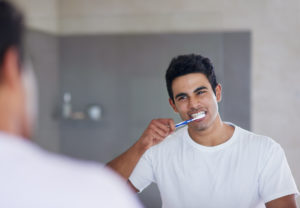 Do You Brush Your Teeth Correctly? Maybe Not
Do You Brush Your Teeth Correctly? Maybe Not
Many adults have been brushing incorrectly for their entire lives and have no idea that they are doing it wrong. In a study it was found that proper oral hygiene training resulted in a 50% reduction in plaque scores after only 3 months of active therapy.(DeVore et al., 1990)What does this mean? Many adults are practicing improper oral hygiene methods.
How Does This Happen?
The Bass Method and the Modified Bass Method have been found to be the most effective ways to brush. We will explain that in detail below. With these methods, the bristles reach only .5mm to 1mm below the gingival margin (the area between the gum and the tooth). (Waerhog, 1981) This is important for several reasons. First, this is where much of the accumulation occurs. These accumulations, if not removed, are what cause caries and subsequent cavities. Second, this shows that the toothbrush does not penetrate very far into this area. Compare this to other methods of cleaning. Flossing reaches an average of 3mm and scaling done by your hygienist has an average instrumentation limit of 6.21mm. Finally, the difference in percentage between .5mm and 1mm is significant. These things all lead to the conclusion that the method of tooth brushing is critical for healthy teeth and gums.
How Long Do You Brush?
Try this at home. Set a timer next time you brush. Brush as you normally do then look at the timer. Is it 2 minutes? Most people report to being less than half of that value. The time spent brushing has been shown to be more critical than the method, brand and style of toothbrush, or age of toothbrush.
Are Powered Brushes More Effective than Manual Brushes?
Several studies have been done to determine the answer to this. There were inadequacies of each of the studies. With that being said, a recent study showed patients that brushed with the manual Bass technique had 3 times more plaque than those using a Sonicare powered brush and 11.9 times more plaque between the teeth in the back of the lower front teeth. One criticism of the powered brushes by dentists is that there are many recommendations to eliminate flossing for powered toothbrush users. We all vary on our risk level for plaque, calculus, and dental caries and that decision should be addressed individually.
The Proper Manual Technique
Charles C. Bass developed the Bass technique in the 1940’s after his retirement from university administration. The Bass technique and the Modified Bass technique have since become the standard for which much of our country’s oral hygiene instruction has been based.
First and possibly most importantly, the angle of the toothbrush has been found to be the largest source of error with patients. Bass instructs to hold the toothbrush at a 45 degree angle toward the sulcus (the area where the teeth meet the gums). This allows the bristles to properly penetrate into the critical areas. This picture illustrates the proper angle.
Second, brushing should be performed in a circular motion using small circles. Adequate overlap should be used to ensure that there are no areas that are missed.
Should I Rinse After?
Most tooth pastes have the proper amount of fluoride added. This addition has been shown many times to be of benefit for the prevention of decay. If you rinse after brushing you will wash away the fluoride delivered from the toothpaste and decrease it’s efficacy.
Should I Use Mouthwash?
If you would like to freshen your breath between brushings then mouthwash is great. Most mouthwashes without fluoride serve no purpose other than this freshening. Alcohol has also been shown to kill “good” bacteria in the mouth. Most people that use mouthwash have been taught to use it after brushing. There is, however, one large criticism to using mouthwash after brushing. Most of the over the counter fluoridated mouthwashes actually contain less fluoride than your toothpaste. When rinsing with this you wash away much of the fluoride from the toothpaste and the result is just the fluoride delivered by the mouthwash.
How Often Should I Change My Toothbrush?
A recent study showed that toothbrush wear is not as important as previously thought. Twenty two dental students were chosen and instructed on the Bass technique and their plaque scores were compared to the baseline. Plaque scores were found to actually decrease at 30, 60, and 90 days. Some previous recommendations were that patients changed toothbrushes even every 30 days. Most dentists will recommend changing your toothbrush every three months and this seems like the soonest that would prove benefit.
Ponte Vedra Complete Dentistry is a general and cosmetic dentist located in Ponte Vedra Florida. PVCD features caring, trained and skilled doctors who will work hand-in-hand with you to create a treatment plan that protects and restores your teeth and bite to their ultimate health and beauty, and a staff ready to address your every need. For any additional information or for a consultation please call Ponte Vedra Complete Dentistry at (904) 285-7711 or contact us online.



